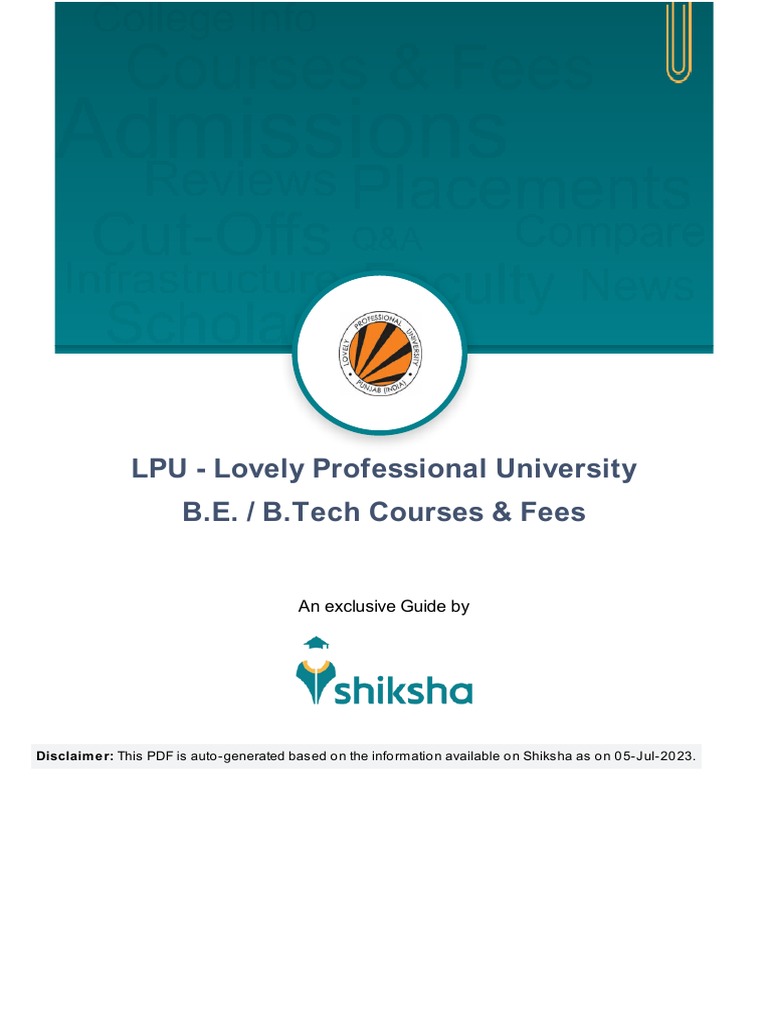The landscape of higher education has undergone a tremendous transformation, particularly in the realm of design. Various institutions have emerged, each purporting to offer cutting-edge courses that promise to sculpt adept professionals equipped for an ever-evolving industry. Among these, Lovely Professional University (LPU) in India often garners attention. The question arises: Is LPU truly a commendable choice for pursuing a designing course? This inquiry requires a dissection of several critical factors, including curriculum, faculty qualifications, infrastructure, industry collaborations, and the overall academic environment.
Firstly, let us consider the curriculum offered at LPU. A designing course must not only encompass foundational principles but also integrate contemporary trends and technologies. LPU’s curriculum is meticulously designed to meld theoretical knowledge with practical applications. The incorporation of hands-on projects allows students to delve deeply into their creative pursuits, ensuring that they grasp the nuances of design thinking and innovation. Furthermore, the emphasis on interdisciplinary learning, where design converges with technology, business, and sociology, prepares students to navigate the multifaceted challenges they will face post-graduation. This aspect of LPU’s educational philosophy promises a transformative experience for aspiring designers, fuelling their intellectual curiosity and equipping them with skills applicable across various industries.
Equally vital is the caliber of faculty involved in imparting this knowledge. LPU boasts a diverse faculty comprising seasoned professionals, academicians, and industry veterans who bring a wealth of experience to the table. This mélange of expertise not only enriches the classroom experience but also fosters a stimulating environment conducive to exploration and inquiry. Faculty members often engage in research, ensuring that they remain abreast of global design trends and techniques. Such engagement inevitably permeates their teaching, providing students with insights that extend beyond textbook learning. The opportunity to interact with such knowledgeable instructors can significantly influence a student’s educational trajectory and instill a passion for lifelong learning.
Infrastructure is another pivotal aspect to consider when assessing LPU’s suitability for design education. The university prides itself on its modern and well-equipped facilities, providing students access to state-of-the-art laboratories, workshops, and studios. These avant-garde resources are essential for practical learning, enabling students to experiment with a variety of materials and technologies. Such exposure not only hones technical skills but also encourages creative risk-taking, a fundamental aspect of effective design. The vibrant campus environment further reinforces LPU’s commitment to fostering innovation, offering an engaging backdrop where students can explore and develop their aesthetic sensibilities.
Industry collaborations serve as a critical bridge between academia and real-world application. Recognizing the necessity of industry readiness, LPU has fostered strategic partnerships with numerous design firms, corporations, and organizations. These partnerships often manifest in the form of internships, workshops, and guest lectures, providing students direct exposure to the industry’s demands and expectations. Such experiences are invaluable; they act as a conduit through which students can apply what they learn in class to real-world challenges. Engaging with industry experts equips students not only with practical skills but also with professional networks, vital for career advancement upon graduation. LPU’s endeavors in this regard significantly enhance its appeal as a choice for design education.
Beyond the tangible elements of curriculum, faculty, and infrastructure, the overall academic atmosphere plays an integral role in shaping a student’s educational experience. LPU fosters a culture of creativity, collaboration, and diversity. Students from varying backgrounds converge, exchanging ideas that spark innovative thinking. Such an enriching environment encourages learners to step outside their comfort zones, pushing the boundaries of conventional design. Additionally, extracurricular activities, including design competitions, exhibitions, and community projects, further galvanize students’ skills and bolster their confidence. This holistic approach to education cultivates not only proficient designers but also well-rounded individuals prepared to thrive in the competitive design ecosystem.
Furthermore, it is imperative to analyze the success stories stemming from LPU. The university has produced an array of accomplished alumni who have made significant strides in the design industry. Their success narratives serve as testimonials to the efficacy of LPU’s educational model, suggesting that the institution adequately prepares its students for transformative careers. Engaging with alumni can offer prospective students insights into the potential trajectories they may pursue post-graduation, thereby piquing their curiosity about the possibilities that await them.
Conversely, it is crucial to approach this topic with an analytical lens. Prospective students should engage in rigorous self-reflection, evaluating their personal aspirations, creative inclinations, and preferred design disciplines. While LPU presents an attractive option, it is essential to ascertain whether its offerings align with individual career goals. Conducting thorough research, visiting the campus, and interacting with current students and faculty will contribute to a more informed decision-making process.
In conclusion, Lovely Professional University emerges as a strong contender for individuals aspiring to delve into the realm of design education. Its robust curriculum, seasoned faculty, advanced infrastructure, and fruitful industry collaborations craft an environment ripe for innovation and creativity. Nevertheless, this assessment must be harmonized with personal aspirations and proactive exploration of the university’s offerings. For many, LPU may indeed serve as the catalyst they require to transition into a dynamic and fulfilling career in the design industry, promising a shift in perspective that aligns with their creative ambitions.












